Simulation transformation: Virtual reality tool is classroom-ready
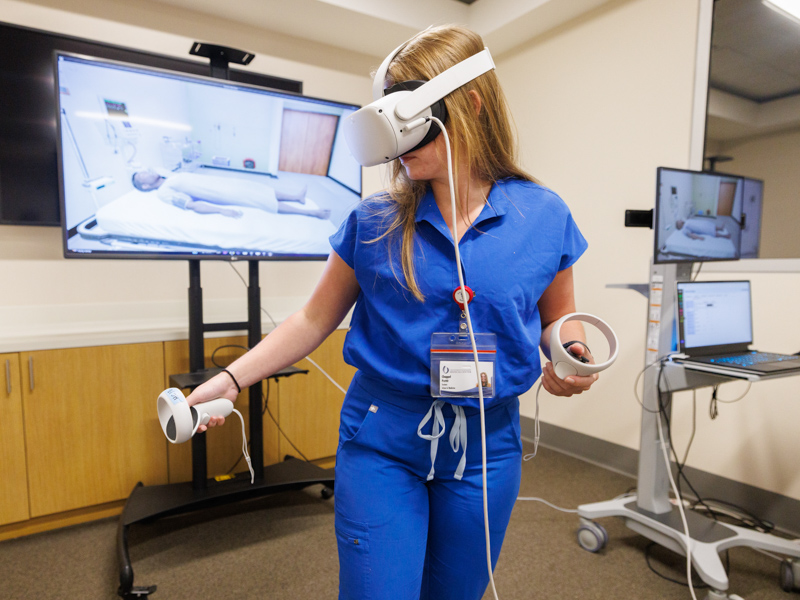
If Dr. Emily Tarver’s software program, SimGym, somehow attracted a gaming website review, it might go like this:
Simulated patient care never felt so fresh and futuristic. This shrewd design lays out a 3D clinic or ER room you navigate, making excellent use of VR.
If you love customizing patient cases, retrieving X-rays from a virtual laptop, adding a code cart or defibrillator with a click, or cybernetically tailoring your medical equipment, then the dynamic SimGym is for you.
Obviously, SimGym is not a game. Its creator ordained it for serious work from the moment she envisioned it a few years ago.
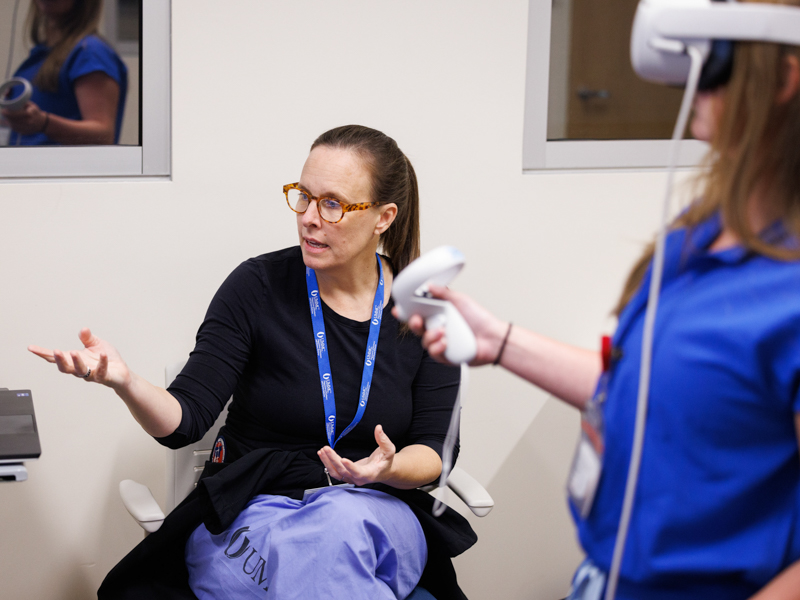
“It’s a virtual reality simulation tool that can be used to teach in the classroom and in lecture halls,” said Tarver, associate professor of emergency medicine and co-director of virtual reality and simulation at the University of Mississippi Medical Center.
“Theoretically, you can use it for any type of case.” That means even low-occurring ones, and even mass casualties.
As it happens, SimGym has received real reviews:
- Anna Lerant, professor of anesthesiology, managing director of the Simulation and Interprofessional Education Center (SIEC): “SimGym teaches clinical decision-making, in a relevant, up-to-date and immersive environment.
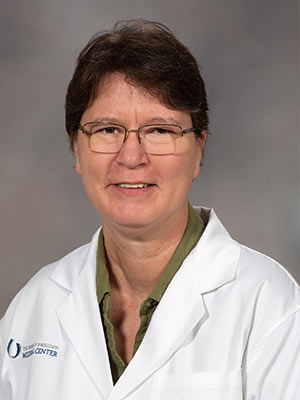
“It is instructor-driven, just like the simulations we do on high-fidelity manikins, with real-time debriefing after each scenario. It is applied clinical thinking at its best, in a very cool and inspiring format.”
- Alaina Herrington, assistant professor of nursing, director of the Gearhart Clinical Skills Center and founding director of the Mississippi Academy for Simulation Training (MAST): “I can’t wait to see the impact SimGym has on the state’s schools of nursing.
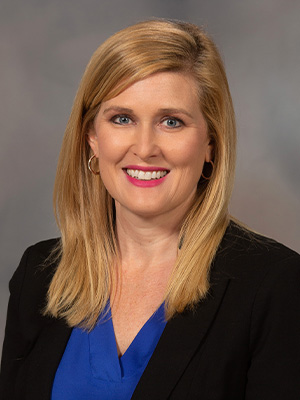
“Sharing this virtual reality resource will enable Mississippi educators who participated in MAST to bridge between traditional classroom learning to real-life clinical experience. Without the access to SimGym, it is possible our states’ learners would be entering the nursing workforce less prepared than others.”
This states’ learners, if they own a gaming system, may even do Sim Gymnastics from home. That might be music, or at least a striking chord, to Zoomers' ears.
“Gen Z has more virtual-reality experience than previous generations,” Tarver said. Soon enough, members of most every generation should know it like the back of their avatar’s hand, as one scientific journal reports.
By virtue of a headset or helmet, VR plunges the user into worlds that startle with their realism, no matter how far-fetched or extra-terrestrial. But it’s also doing its part for more down-to-earth purposes – for culture, education, architecture, medicine. And, more to the point, teaching medicine.
“As an emerging and new technology, VR has the potential in transforming medical teaching,” concludes a study published in BMC Medical Education.
So, Tarver says, let the transformation begin. At UMMC, she should be a big part of such a change.
“The simulation here is incredible,” Tarver said. “But there is so much demand for it. I wanted to create more access to simulation training.” Those were her thoughts in 2019. The following year, COVID perversely validated her thinking.
“The pandemic really challenged our ability to provide simulation training because of in-person learning restrictions,” Tarver said.
Marshaling the forces of VR software presented a way to potentially counterattack COVID, education-wise, by enabling remote and in-person training on a virtual patient. It’s somewhat similar to the manikin-based training offered in the SIEC, only with pixels instead of plastic.
As an advocate for VR-based learning, Tarver has a lot going for her: She completed UMMC’s first-ever simulation fellowship last year.
Even before that, she went to work on SimGym, starting with a VR gaming system she bought for her home. Standing with her have been her simulation-training colleagues, physicians at the Medical Center, and from clear across the ocean, Tom Dolby.
“Tom Dolby knows this software better than anyone and has been a huge help and collaborator every step of the way,” Tarver said. In the fall of 2020, she reached out to the chief technology officer at i3 Simulations in Luton, England, and a partnership was born.
“It’s been a very ambitious project, also a very powerful one,” Dolby said. “We have a lot of ideas to keep growing it.”
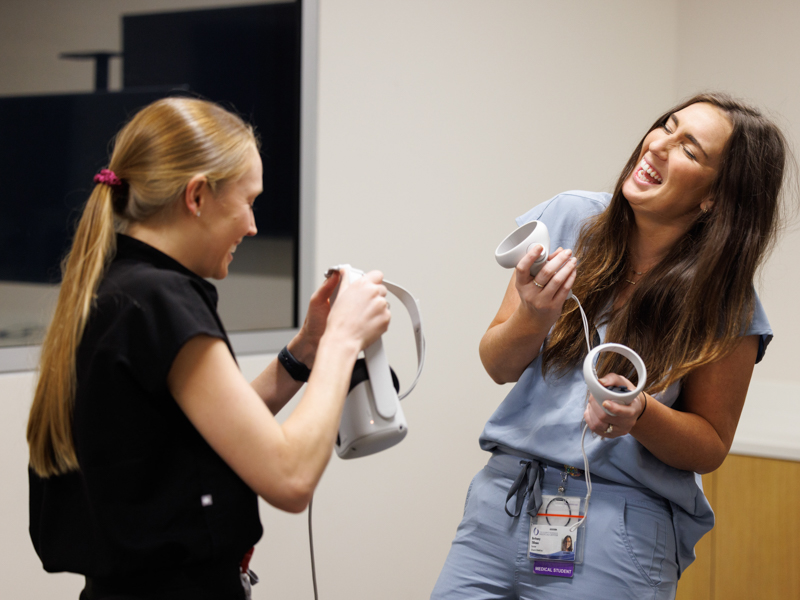
i3 Simulations came into the world about the time Tarver’s idea for SimGym did; i3 was founded as a software development company focusing only on health care. So, Dolby has seen, and helped build, SimGym-like creations before. Tarver’s is different, he said.
“You have complete customization – what type of room you’re working in, clinic or trauma bay; you have more than 30 different types of patients, covering a range of ethnicities, age and more.”
The settings include an ICU, two ER rooms, an outpatient exam room and inpatient hospital room.
“You can customize injuries, conditions, vital signs,” Dolby said. “You can build out your room with the equipment you want on your case. And the instructor is in complete control every step of the way.”
During a demonstration in the SIEC earlier this month, Chappel Pettit donned an Oculus VR headset and prepared to be teleported. As Tarver observed her SimGym encounter on a monitor, the medical student moved around in a 10 x 10-foot area – the recommended size.
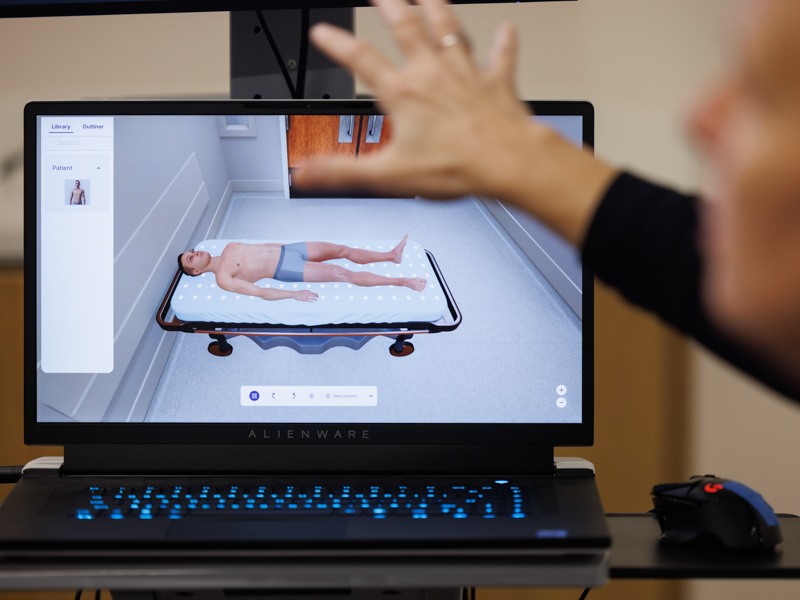
With a hand controller, she manipulated a disembodied pair of helping hands which can perform such procedures as chest compressions on the virtual patient while the learner attends to other matters.
Pettit’s patient could stand up, lie down, sit the edge of the examining table, blink, shrug his shoulders, give a thumbs-up, display body language to express himself: “no way,” “sure,” whatever.” And she could choose a different patient, if she wanted.
“The versatility of SimGym was what struck me the most,” Pettit said later. “The ability to change so many parts of the simulation, including the patient, room, and the tools and devices found inside, may allow this technology to be utilized in any field of medicine.
“It could become a very important learning tool for students, replacing more traditional ways of learning like PowerPoint slides, or used as a supplementary tool.”
Still, SimGym is not static. Tarver tapped into the federal government’s Higher Education Emergency Relief II Fund to develop phase one of the software. It’s had over 40 iterations and is ready for wider testing. One goal for later renditions: multiple patients on screen made available to several students simultaneously.
She wants patients to be able to move their eyes for hand-tracking. And she is seeking funding for ChatGPT integration so that caregivers and patients – who, for now, can’t speak – can have conversations.
For his part, Dolby foresees other improvements, such as cloud processing, “so you can run it on anything, including your phone.”
At the moment, Tarver, as an ER professor, plans to integrate SimGym into the emergency medicine curriculum. “Except when I’m on shift, the best way for me to pass on my emergency medicine knowledge is SimGym,” she said.
“I don’t know if it will be for everyone, but it is an alternative. And it will be ready for primetime when everyone else is.
“But there is no limitation to what we can do or what we can build. The only limitation is us – figuring out how it best meets our needs.”


